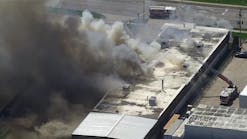Basement fires, or cellar fires, are some of the most difficult, challenging and dangerous operations you will ever encounter. Lots of basement fires result in loss of buildings and loss of life. Let's take a look at the challenges we face and how we may be able to handle them.
Basement fires often are difficult to recognize. With most of the fire area beneath the first floor, the only smoke or fire visible may be coming from the first floor. If you don't look farther, you may launch a fire attack into the first floor and end up unknowingly operating above the fire. This will almost certainly result in firefighters looking for fire that is not there and operating on top of floor joists being compromised by the fire below. Someone must examine the basement to make sure that what looks like a first-floor fire is not burning in the basement. This can be accomplished by finding and venting an above-grade basement window or locating a stairway or other entrance and examining the basement for smoke or fire.
The next difficulty is stretching your hoseline or advancing with a search team down the stairway. When the fire is in the basement, the heat and smoke and flames are trying to go up and out. Up and out is up the interior stairway. When you open the door at the top of the stairs, you will be met with tremendous heat and smoke pushing up the stairway enclosure that you are trying to go down. If there is no other way into the basement, you have your work cut out for you.
The best way to get down a stairway to a basement fire is fast! The faster you go, the faster you will reach the most tolerable conditions, which are at the bottom of the stairway. If you are advancing a hoseline, you need to make a large loop of hose at the top of the stairs on the landing or in the adjacent hallway. When you are ready to make your move, rapidly move down the stairs, feet first without stopping.
Do not stop! If you do, you will immediately reverse direction and find yourself at the top of the stairs again. Once you begin the descent, don't even think about stopping until you hit the floor. Also, this initial rapid descent is made by two and only two people. It should be the officer and the nozzle firefighter. More than two people going down the stairs under these treacherous conditions will only make for a slower and more punishing descent. After the first two members reach the bottom, the next two firefighters can move down in a similar manner.
Another hazard is rapid fire development and spread. Many basements have no walls and doors. Many basements in private dwellings and commercial buildings alike are wide-open areas with large amounts of flammable stock, furniture and other debris. Once a fire takes hold, it can rapidly spread across the ceiling in seconds and trap or threaten firefighters operating down there. Engine firefighters with a hoseline will be more able to protect themselves, but they too can be overrun by a rapidly spreading fire. Truck company firefighters are in even more of a predicament without the protection of a hoseline.
Disorientation is another major challenge. Basements often are not furnished and are simply stuffed full of boxes, storage shelves, drums and other items in no particular layout. Firefighters who are advancing through a basement searching for a fire can quickly and easily become lost and disoriented. This is compounded by the fact that once this occurs, even if the firefighters call for help, they can't even guide the rescuers to where they are because nothing around them may be recognizable in the heavy smoke conditions. Firefighters entering basements, even in private dwellings, should bring and use a search rope. If conditions change or if fire suddenly spreads, at least the firefighters will have a route to follow back to the safety of the stairway.
Collapse is another dangerous condition. Many unfinished basements have exposed ceilings that are actually are the floor joists and floor boards of the first floor. A medium or heavy fire can quickly compromise the integrity of these components and the floor above can partially or completely fail and collapse into the basement, trapping the firefighters below. This is even more pronounced when the structural elements are lightweight components such as trusses, C-joists, or one of the many other unsafe and substandard building components and the collapse can be as tragic to firefighters operating above the fire as it is to those in the basement.
Basement fires are dangerous and difficult and need to be handled with care. Review these difficulties and potential solutions before you arrive at your next one.
JOHN J. SALKA Jr., a Firehouse® contributing editor, is a 28-year veteran battalion chief with FDNY, the commander of the 18th battalion in the Bronx. Salka has instructed at several FDNY training programs, including the department's Probationary Firefighters School, Captains Management Program and Battalion Chiefs Command Course. He conducts training programs at national and local conferences and has been recognized for his firefighter survival course "Get Out Alive." Salka co-authored the FDNY Engine Company Operations manual and wrote the book First In, Last Out — Leadership Lessons From the New York Fire Department. He also operates Fire Command Training (www.firecommandtraining.com), a New York-based fire service training and consulting firm.





